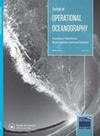波斯湾风浪预报系统之效能评估
IF 2.4
3区 地球科学
Q4 METEOROLOGY & ATMOSPHERIC SCIENCES
引用次数: 0
摘要
利用JASON2、CRYOSAT和SARAL/AltiKa三颗卫星和两个浮标的数据,对波斯湾风浪预报模型的性能进行了研究。首先通过将卫星数据与浮标数据进行比较来检验卫星数据的质量。发现所有三颗卫星的风速数据与现场测量值接近;对于波高,SARAL/AltiKa的数据显示了最好的对比。模式预报和浮标数据表明,风速的相关系数在0.72 ~ 0.86之间,浪高的相关系数在0.85 ~ 0.94之间。远海浮标的预报精度高于沿海浮标。与SARAL/AltiKa数据相比,相关系数在0.86至0.90之间,后者是评估模拟波高的首选数据。对于模拟的风速,与合并卫星数据集的相关系数在0.80到0.88之间。有些反常的结果部分是由于排除了海气温差。对某一预报代表某一海况的可能性进行了估计。一般来说,对于长达48小时的预估时间,用户可以有78% - 92%的预期,SWH预测> 1米将位于由SARAL/AltiKa测量所代表的海况的±30%范围内。本文章由计算机程序翻译,如有差异,请以英文原文为准。
Performance assessment of a Persian Gulf wind and wave forecasting system
ABSTRACT Data from three satellites (JASON2, CRYOSAT, and SARAL/AltiKa) and two buoys were used to examine the performance of wind and wave forecasting models in the Persian Gulf. The quality of the satellite data was first examined by comparing them with buoy data. Wind speed data from all three satellites were found to be close to in situ measurements; for wave heights, SARAL/AltiKa data showed the best comparisons. Model forecasts and buoy data indicated correlation coefficients between 0.72 and 0.86 for wind speeds and 0.85–0.94 for wave heights. The forecast was more accurate at the open sea buoy than at the coastal buoy. Relative to SARAL/AltiKa data, which was preferred for assessing modelled wave heights, correlation coefficients were between 0.86 and 0.90. For modelled wind speeds, correlation coefficients with the consolidated satellite dataset were between 0.80 and 0.88. Some anomalous results were partly attributed to the exclusion of air–sea temperature differences. The likelihood of a given forecast representing a given sea state was estimated. Generally, for lead times up to 48 h, a user could have a 78–92% expectation that a SWH forecast > 1 m would lie within ±30% of a sea-state represented by the SARAL/AltiKa measurements.
求助全文
通过发布文献求助,成功后即可免费获取论文全文。
去求助
来源期刊
CiteScore
7.50
自引率
9.70%
发文量
8
审稿时长
>12 weeks
期刊介绍:
The Journal of Operational Oceanography will publish papers which examine the role of oceanography in contributing to the fields of: Numerical Weather Prediction; Development of Climatologies; Implications of Ocean Change; Ocean and Climate Forecasting; Ocean Observing Technologies; Eutrophication; Climate Assessment; Shoreline Change; Marine and Sea State Prediction; Model Development and Validation; Coastal Flooding; Reducing Public Health Risks; Short-Range Ocean Forecasting; Forces on Structures; Ocean Policy; Protecting and Restoring Ecosystem health; Controlling and Mitigating Natural Hazards; Safe and Efficient Marine Operations

 求助内容:
求助内容: 应助结果提醒方式:
应助结果提醒方式:


